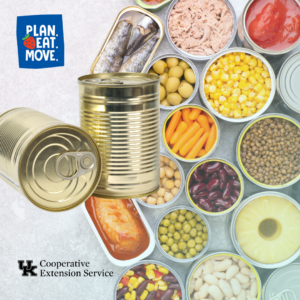Many people recognize the benefits of fruits and vegetables and the important role they play in their health. You can choose a variety of fresh, frozen, dried, dehydrated, or canned options to incorporate more fruits and vegetables into your diet. Canned items are convenient, affordable, and are available year-round.

Whether it is commercial or home preservation, the canning process uses heat to kill bacteria that spoil food. It ensures a longer shelf life. Use low-acid canned foods, such as vegetables, within three years and high-acid canned foods, such as fruits, pickles, and tomatoes, within two years of their use-by date. When selecting canned items, avoid cans that have dents, rust, bulges, cracks, or leaks. If noticeable damage is present, it could mean exposure to bacteria, making the items not safe to eat. Keep canned goods in a cool and dark place, such as in a pantry or a cabinet, for safe and proper storage. Doing this means you can create quick meals or snacks without having to plan or grocery shop.
Fruits and vegetables are canned at peak freshness in order to preserve nutrients and maintain flavor so you can enjoy their benefits throughout the year. Common canned fruit options include peaches, pineapple, pear, grapefruit, and fruit cocktail. You should be mindful of added sugar in canned fruit. Choose options that are unsweetened, packed in 100% juice or in its own juices, or drain and rinse the syrup before using. Combine your choice of canned fruit with fresh fruits, pair with oatmeal or yogurt, or incorporate it in your recipes by substituting for fresh options.
Popular canned vegetable options include tomatoes or tomato sauce, beans, corn, green beans, peas, and carrots. Often canned vegetables have a higher salt content to help with preservation so it is good to choose options labeled as reduced or low sodium or no salt added. Alternatively, we can remove some of the salt by draining and rinsing the contents of the can. Use your favorite options as a side to your favorite protein, add to your salads, or incorporate them in cooking. Make a quick meal by using whole-grain pasta, canned tomato sauce, canned peas or carrots, and your choice of canned beans. Canned vegetables are great to have on hand for soups and stews, too.
A diet high in fruits and vegetables can reduce the risk for many chronic diseases. Eating canned fruits and vegetables can help us consume more nutrients, such as potassium and fiber, and vitamins, such as A and C, that are important for our overall health. Canned fruits and vegetables are also great options for kids, older adults, or people who might have trouble chewing because they have a soft texture. Keep your favorite canned items on hand and enjoy them at your next meal or snack.
References
https://www.myplate.gov/eat-healthy/vegetables
https://www.eatright.org/food/vitamins-and-supplements/nutrient-rich-foods/are-canned-foods-nutritious-for-my-family
Source: Paulina Antimisiaris, Dietetic Intern; Emily DeWitt, Senior Extension Associate for Family and Consumer Sciences Extension


For more information and resources related to canned foods check out our USDA partners – The Canned Food Alliance: https://www.mealtime.org/